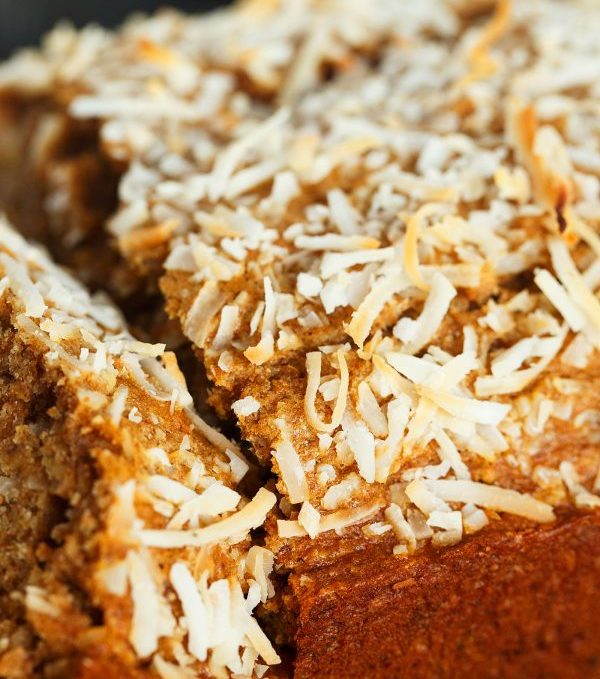Vegan Coconut Banana Bread Recipe

Rudra Manohara
Yoga Farm Staff
Rudra Manohara is a Yoga Farm chef, course instructor, staff member and teacher of Classical Hatha Yoga. He is professionally trained and has over 15 years experience in both the culinary arts and massage bodywork therapy, as well as a background in theatre and dance. View Profile >
Ingredients:
- 4 1/2 cups whole-wheat pastry flour or unbleached all-purpose flour
- 2 tsp baking powder
- 2 tsp baking soda
- 1 tsp cinnamon powder
- 1/4 tsp freshly grated nutmeg
- 1 tsp salt
- 1 cup sucanat or brown sugar
- 2 cups dried, unsweetened flaked coconut (1/2 cup reserved for topping)
- 3 cups mashed ripe bananas
- 1/2 cup coconut oil, melted and slightly cooled
- 1 1/2 cups coconut milk
- 1 Tbsp vanilla
- 1 1/2 cups semi-sweet or bitter chocolate chips *optional*
Directions:
1. Preheat the oven to 325 degrees Fahrenheit. Lightly grease a 9″ x 13″ baking pan or Pyrex dish.
2. Whisk together in a large bowl the flour, baking powder, baking soda, cinnamon powder, nutmeg, salt, brown sugar and 1 1/2 cups of dried coconut.
3. Combine in a separate bowl the mashed bananas, melted coconut oil, coconut milk and vanilla.
4, Mix together the prepared dry and wet ingredients, just until combined (do not overmix). Gently fold in the chocolate chips, if using.
5. Pour batter into prepared pan. Sprinkle remaining 1/2 cup of dried coconut on top.
6. Place on middle rack of oven and bake for about 1 hour, or until golden brown on top and toothpick inserted in middle comes out clean.
7. Let cool at least 1 hour before slicing and enjoy!

This vegan coconut banana bread makes a delectable and healthy treat!
Considerations
Below are some tips on how to optimize this recipe for the best taste and effect on health and well-being.
Chocolate Chips
This ingredient can be omitted based on your personal preference. For a healthier option, use dark chocolate chips or low sugar chocolate chips.
If chocolate may be aggravating to your Ayurvedic constitution (dosha), or if you are allergic, you can experiment with carob chips as an alternative.
Banana Ripeness
For banana bread, the perfect banana is one that is mostly yellow with several brown spots. If it has any green on it, even on the stem, wait a day or two. Mushy, slightly over-ripe bananas can work great especially if you don’t want to eat them raw

Soft, ripe bananas with brown spots are best for making vegan coconut banana bread.
Ayurvedic Considerations
Ayurveda is a sister science of Yoga that specializes in customizing diet based your constitution (dosha). We recommend learning more about your dosha through an Ayurveda class, a consultation with an Ayurvedic practitioner or an online dosha quiz.
Vata
For Vata dosha, which tends to be more dry and active, bread with yeast can be aggravating as they have a lot of air element. This Banana Bread may be less aggravating since it is moist and rich and has no yeast. To further its pacifying effects on Vata, we recommend slathering on some ghee (clarified butter) or coconut oil if you are vegan. Eating it while it’s still warm and soft will also help pacify Vata.
Pitta-Vata
If you have Pitta and Vata tendencies, it is especially recommended to skip the chocolate ingredient, as it can be overstimulating, heating and drying.
Pitta
Pitta is the dosha that is hot and sharp. If you are predominately Pitta dosha, leave the chocolate chips out as it can be too heating. The moist, whole grains and coconut milk/flakes in the bread will already pacify Pitta. You can also use a little ghee or coconut oil, but don’t go overboard as too much oil can aggravate Pitta. Let the bread cool down a little longer before eating.
Kapha
Kapha dosha tends to be heavy, moist and stable. This heavy, moist and dense banana bread might not be the best option for Kapha Dosha. If you do decide to try it, don’t go overboard – start with a small piece, and skip the extra ghee or coconut oil.
Kapha individuals should favor dry and light grains over heavy and moist ones. If you are Kapha and you must try this banana bread, try toasting a thin piece until crispy and garnish with teaspoon of ground flax, pumpkin and/or sunflower seeds on top and a pinch of cinnamon.

Adding ayurvedic spices to your food can aid with healthy digestion.
Seasonal Considerations
Ayurveda also considers different diets and lifestyles for each season in order to align with the body’s natural needs.
Summer
Ayurveda emphasizes cooling ingredients such as yogurt, cucumber, fresh fruit and salad to balance excess heat in the body.
Autumn
In Autumn, it is recommended to eat grounding, sweet foods such as squash and use warming spices like cinnamon or clove.
Winter
In winter, the body needs a balance between sweet, sour, salty, pungent, bitter, and astringent tastes in the form of warm, hardy stews to keep the body warm, blood flowing and clear mucous.
Spring
Spring time is a time for detoxification and light, pungent, bitter and astringent foods such as sprouts or lemons are encouraged.
When to Eat this Banana Bread
We recommend this banana bread for late autumn or early winter because of its balance of warming spices and grounding wholesome ingredients. We recommend late autumn and not early because it is a better time for a detoxifying kitcheri cleanse to prepare the body for the transition of seasons. It would not be an ideal food for springtime when the body is trying to get rid of excess toxins and weight built up during the winter. It can be a cooling dessert in the summer time if served room temperature and eaten in moderation.
If you are interested in learning more about healthy diet and nutrition, check out our cooking and detox courses at the Yoga Farm.
2 Comments
Submit a Comment
Follow us
[et_social_follow icon_style=”slide” icon_shape=”rounded” icons_location=”top” col_number=”2″ counts=”true” counts_num=”0″ outer_color=”dark”]



I was under the impression that we don’t mix fresh/ripe fruit with other cooked ingredients as it provokes amma; and to use dried fruit, eg., soaked raisins and dates for baking. Can you please advise?
Thanks for your comment. This recipe is not necessarily a traditional ayurvedic recipe. But it is a recipe used at the Yoga Farm quite often.
In general cooked fruits with a meal is ok for digestion. Maybe not every day, but once in a while as a treat.
It is much better then raw fruits which should only be taken 1-2 hours before or after a meal.